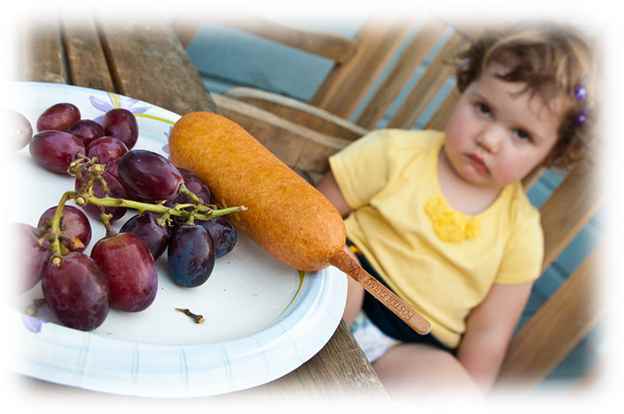9 tips to help parents of children who are fussy eaters
And how to introduce new foods to your kids
OK, I know this article isn’t strictly in the storytelling arena, but my daughter is a fussy eater, so I thought I’d share some tips that may or may not help if your kids pick at their food and pull silly faces and make disturbing sounds at something as ordinary as brocoli or a roast potato.

You’ve spent ages in the kitchen preparing something you’re certain your beloved son or daughter will love!
It’s got all the things that you know they love and you’re really pleased that you’ve found an awesome recipe that combines all these healthy foods together…
(You know where this is going don’t you…)
“I DON’T LIKE IT!!!”
Sound familiar? If you’ve read my previous article about choosing children’s story books to read at bedtime, then it has a startling similarity.
There are several tips that a parent can use to help their children that are fussy eaters.
Tip 1: Respect your child’s appetite
…Even if they do not have one. This means that if your child is not hungry, do not force them to eat.
This includes (and I don’t know a parent who hasn’t resorted to this at technique) never bribing your children to eat certain foods.
This is because if a parent does this to their child, then the child is going to associate meals with (at best) “payment” and we all know that rewards suffer from inflation – over time they become worth less to the recipient.
What I found was that the problem for my daughter wasn’t her appetite: it was me!
I was giving her too big, and therefore daunting, portions!
Simply cutting the size of the portions will avoid overwhelming your kid’s sense of what we expect of them.
Tip 2 : Stick to routine when it comes to eating
Yes, this does mean that our children need to eat their meals at the same time every day.
Difficult?
Impossible I’d say, so lets move swiftly on and hope that the other tips provide a more usable solution…
Tip 3: Liquid control
A great tip for adults who want to lose weight is to drink a large glass of water before their meal. This is because it fills us up and can help us exert portion control.
Children, and my daughter in particular, can fall into drinking their fill right before they should be eating resulting in a reduced appetite and concerned parents.
Over the course of a couple of weeks, I weaned my daughter gently off the juice and squashes she’d have at meals and on to water. This meant that she didn’t feel the need to down her whole cup right before I was about to serve her some delicious, warm and lovingly prepared healthy victuals.
Tip 4: Serve with a friend to help introduce new foods
In his book “What the Dog Saw: And Other Adventures” Malcolm Gladwell mentions, almost in passing, that children evolved to avoid new foods at age 2 or 3. About the time that, in prehistoric times, they’d have started helping gather food for the family and therefore “trying” new plants and berries would have been a decidedly risky thing to do.
For us modern parents this holds all sorts of “ahhh” type moments (I know I had one when I read that paragraph) but conveniently, the chapter is all about tomato ketchup and it turns out that smothering new foods with a favourite sauce or other accompanying treat can help bridge the gap between “safe” foods and “new” foods.
By the way, I can’t recommend Malcolm Gladwell’s books enough – they really have so much to offer the aspiring parent!
Tip 5: Make it a discovery for all the senses

Make the experience of eating the new (or indeed difficult/healthy) foods fun and involve senses other than taste.
Cut or shape food into interesting shapes.
Talk about the colour and texture of the food.
What other animals can they think of that might like it?
Get imaginative and tell a story!
Tip 6: Ask them for help
When shopping (and I am assuming that you’ve managed to get your kids to go shopping without causing a fuss/chaos), get your child’s opinion on what to buy. Ask them to help you pick out the vegetables.
Show them how to identify a ripe tomato or mango and then get them to find the ones that you’re going to have for lunch.
When you get home, ask your kids to help you wash and prepare the food they’ve chosen.
I have to say though: this tip is great in principle and may work for some kids, but sadly my daughter is quite the make-believer and she’ll quite happily fill the basket with star fruit and ginger and anchovies and all sorts but point-blank refuse to eat any of it (even smothered in ketchup) once we’re home. she seems to dissociate the whole food from the cooked food. Maybe I need to spend more time filling that gap and get her help in the cooking…
Tip 7: Be sneaky
Back fires more often that it succeeds, so avoid this one unless you have the time and awareness to spot when your kid’s in an open-minded mood and then just place new foods with their regular meal.
If you get it right (and I have to say that I can count the times I have on one hand), then bingo! (though don’t expect that just because they liked it this time that they’ll like it next)
BUT
Be careful as you want and need your child to trust you around their food or they’ll become even more fussy!
Tip 8: Distractions
No TV or gadgets, books or games at the table. Focus on the eating.
I’ve had no luck with this with my daughter. She’s just as fussy with or without any distractions.
It is however, a great opportunity to encourage good manners and to help them learn to use a knife and fork properly, eat with their mouth full or spend a bit of family time as you share your meal together.
Tip 9: Dessert (or pudding in the UK) should be after the main course
Not instead of it. Puddings are often sweet and can be considered the best part of a meal to a child. My daughter, if she knows there is a pudding, will often eat her main course lightly in favour of getting to the pudding more quickly. Obviously this isn’t acceptable, so being firm and consistent and not letting her have pudding until she’s finished (or at least eaten most of) her main is part of the course.
Bonus Tip: Do not treat your child’s meal differently from everyone else’s
By treating our kids’ meals differently from our own, such as making them a special meal because they “don’t like” the one that everyone else is having, we set a dangerous precedent and also highlight the differences. This is not going to encourage them to eat what they’re given, nor give them the balanced and varied diet that is essential for growth.
Maybe this bonus tip should have been titled: Stick to your guns. I remember not being allowed to leave the table until I’d eaten all the macaroni and cheese when I was at school even though every mouthful made me gag. Still, to this day, I can’t eat the stuff and I’m not suggesting that such a strong stance on food is needed with our kids today.
—
What I am trying to say is that consistency is the key.
You know that your son or daughter has eaten, and liked, this before, so stick with it.
If the portion size isn’t too big and there’s no other obvious reason why they mightn’t be hungry (like having downed their cup of juice right before the meal), then maybe they’re just experimenting with saying “no” and refusing food to find the boundaries.
Happy Eating!
